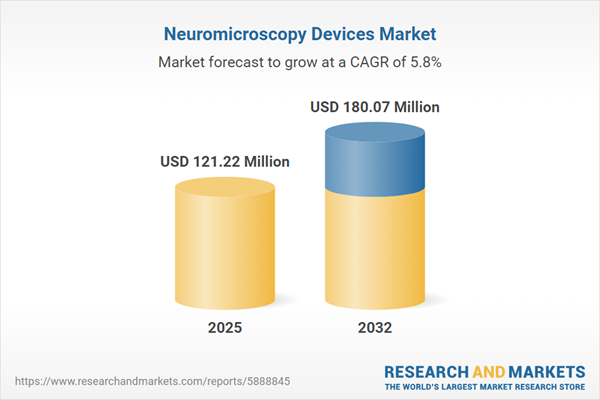Speak directly to the analyst to clarify any post sales queries you may have.
The Neuromicroscopy Devices Market is advancing rapidly, with robust global adoption fueled by innovation in imaging modalities and data integration. Evolving research needs and new clinical applications are driving significant interest among industry stakeholders.
Market Snapshot: Growth and Future Outlook for Neuromicroscopy Devices
The neuromicroscopy devices market grew from USD 114.61 million in 2024 to USD 121.22 million in 2025 and is projected to expand at a compound annual growth rate (CAGR) of 5.81%, reaching USD 180.07 million by 2032. This growth reflects increasing demand for advanced imaging techniques in neuroscience research, clinical diagnostics, and pharmaceutical development, supported by investment and innovation across leading regions.
Scope & Segmentation
This comprehensive report examines the breadth of the neuromicroscopy landscape, covering major techniques, user groups, products, and regions, as well as industry leaders. Key areas include:
- Imaging Techniques: Confocal (point scanning, spinning disk), light sheet (lattice light sheet, SPIM), super resolution (localization microscopy such as PALM and STORM, SIM, STED), and two photon (galvo scanning, resonant scanning) technologies.
- End Users: Academic and research institutes (private centers, public universities), contract research organizations (clinical and preclinical CROs), hospitals and diagnostic centers (diagnostic laboratories, teaching hospitals), pharmaceutical and biotechnology companies (big pharma, biotechnology firms).
- Product Categories: Instruments (benchtop, high end, portable microscopes), services (installation & maintenance, training & consulting), software (data management, imaging analysis).
- Operational Modes: Two dimensional and three dimensional imaging solutions designed for diverse workflows from neuronal culture analysis to intact tissue assessments.
- Geographical Coverage: Americas (United States, Canada, Mexico, Latin America), Europe, Middle East, and Africa (including major markets such as Germany, France, UAE, South Africa), and Asia-Pacific (China, India, Japan, Australia, and others).
- Industry Participants: Analysis of key companies including Thermo Fisher Scientific Inc., Carl Zeiss AG, Leica Microsystems GmbH, Olympus Corporation, Nikon Corporation, Bruker Corporation, Oxford Instruments plc, PerkinElmer, Inc., Bio-Rad Laboratories, Inc., and Hamamatsu Photonics K.K.
Key Takeaways for Decision-Makers
- Adoption of advanced imaging modalities, such as super resolution and light sheet microscopy, is enabling unprecedented visualization of neural processes, reshaping research and diagnostic capabilities.
- Integrated workflows that leverage artificial intelligence and cloud computing are reducing manual analysis efforts, increasing throughput, and accelerating insights from complex imaging datasets.
- Collaborative ecosystems are emerging, linking device manufacturers, software developers, and research organizations for the co-development of specialized instrumentation and data solutions.
- Regional expansion is driven by tailored strategies: robust academic funding in the Americas, growing infrastructure investments in Asia-Pacific, and variable regulatory environments across EMEA influencing adoption and product localization.
- The rising need for high-content, scalable imaging platforms in clinical and pharmaceutical settings underscores the commercial relevance of customizable, modular neuromicroscopy solutions.
Tariff Impact: Navigating Global Supply Chains in 2025
Revised United States tariff structures effective in 2025 are affecting global neuromicroscopy equipment supply chains and operational budgets. Increased duties on essential components are prompting manufacturers and end users to reassess sourcing strategies and production locations, resulting in extended lead times and evolving procurement models. Strategic responses include supplier diversification and localized inventory management, which are supporting continued innovation amidst increased costs.
Methodology & Data Sources
This research combines primary interviews with academic leaders and industry stakeholders, extensive secondary data from scientific journals, patent databases, and regulatory filings, and rigorous data triangulation methods. Quantitative analysis of installation trends and software uptake, paired with expert validation, ensures robust, actionable findings throughout the report.
Why This Report Matters
- Supports strategic planning by delivering targeted insights on market drivers, regulatory challenges, and competitive dynamics.
- Enables identification of growth opportunities by dissecting key segments, regional trends, and end-user adoption patterns.
- Equips decision-makers with the intelligence required to mitigate supply chain risks and align product portfolios with current and emerging needs.
Conclusion
The neuromicroscopy devices market is positioned for sustained advancement, driven by technology evolution and collaborative innovation. This report empowers senior leaders with a clear perspective to inform strategic investments and unlock new opportunities in a changing global landscape.
Additional Product Information:
- Purchase of this report includes 1 year online access with quarterly updates.
- This report can be updated on request. Please contact our Customer Experience team using the Ask a Question widget on our website.
Table of Contents
3. Executive Summary
4. Market Overview
7. Cumulative Impact of Artificial Intelligence 2025
Companies Mentioned
The companies profiled in this Neuromicroscopy Devices market report include:- Thermo Fisher Scientific Inc.
- Carl Zeiss AG
- Leica Microsystems GmbH
- Olympus Corporation
- Nikon Corporation
- Bruker Corporation
- Oxford Instruments plc
- PerkinElmer, Inc.
- Bio-Rad Laboratories, Inc.
- Hamamatsu Photonics K.K.
Table Information
| Report Attribute | Details |
|---|---|
| No. of Pages | 192 |
| Published | October 2025 |
| Forecast Period | 2025 - 2032 |
| Estimated Market Value ( USD | $ 121.22 Million |
| Forecasted Market Value ( USD | $ 180.07 Million |
| Compound Annual Growth Rate | 5.8% |
| Regions Covered | Global |
| No. of Companies Mentioned | 11 |









